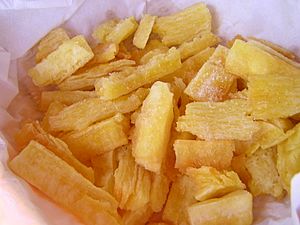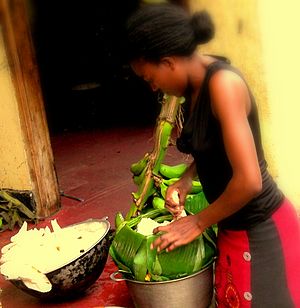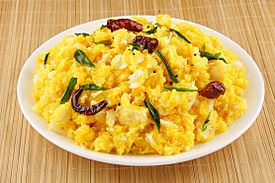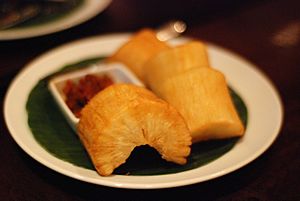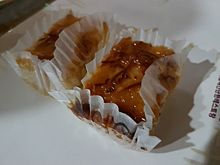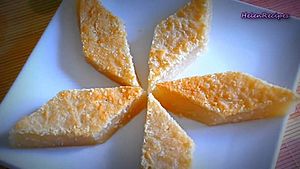Cassava-based dishes facts for kids
Cassava is a super important root vegetable, a bit like a potato, that grows mostly in warm, tropical places. It's also called manioc. You can't eat it raw because it has some natural stuff that needs to be cooked out. But once it's cooked, it tastes pretty mild and can be used in tons of different dishes!
Just like potatoes, you can boil, mash, fry, or even bake cassava. But because it's a tropical plant, people have created some really unique recipes with it, like sweet puddings that you wouldn't usually make with potatoes. In some parts of Africa and Asia, people even cook and eat the leaves of the cassava plant as a vegetable!
To make cassava safe to eat, it usually goes through a process. This often involves peeling, mashing, fermenting, drying in the sun, and then toasting it. This helps reduce the natural compounds that aren't good for you. After this, cassava can be turned into things like garri, tapioca, or cassava flour.
Contents
Cassava Dishes Around the World
Caribbean Delights
In many Caribbean islands, cassava flour is used to make a flat, round bread called casabe or "cassava bread." It's a bit like a giant cracker!
Cuba's Cassava Creations
Cassava is a big part of Cuban cooking. Besides casabe bread, people often boil it and serve it with onion rings and garlic-flavored olive oil. You can also boil it, cut it into strips, and fry it to make yuca frita, which are like French fries. Cassava is also a main ingredient in a traditional Cuban stew called ajiaco, which has lots of other vegetables too.
Cuban buñuelos are sweet fritters made with cassava and sweet potato instead of regular flour. They are fried and then covered with a sweet syrup. You can also find crispy cassava chips called "chicharritas de yuca," which are thin, deep-fried rings of the root.
Haiti's Tasty Treats
In Haiti, cassava, called kasav, is a popular food. It's often eaten as bread, sometimes with peanut butter or milk. Cassava flour, known as musa, can be boiled to make a meal. Cassava also goes well with stews and soups, like the famous pumpkin soup called soup joumou. There are even sweet cookies called bonbon lamindon made from cassava flour that melt in your mouth!
Dominican Republic's Cassava Dishes
Instead of French fries, people in the Dominican Republic enjoy arepitas de yuca. These are deep-fried lumps of shredded cassava mixed with butter, egg, and a hint of anise. They also make empanadas called catibía with cassava flour dough. Boiled cassava is eaten with pickled onions or other root vegetables. Cassava is also a key ingredient in sancocho, a hearty stew.
Puerto Rico's Cassava Favorites
In Puerto Rico, boiled cassava is a common part of sancocho, a typical stew. It can also be ground into a paste to make pasteles, a traditional Christmas dish. These are like Mexican tamales but made with root vegetables and wrapped in a plantain leaf. Alcapurrias are similar but are fried and filled with meat or seafood.
Fried cassava mashed with garlic and olive oil, then stuffed with crispy pork rinds, makes mofongo de yuca. Sweet treats like cazuela (a pie with cassava, squash, and coconut) and spiced cookies called alfajor are also made with cassava.
Jamaica's Bammy Cakes
In Jamaica, cassava is traditionally made into bammy, a small fried cassava cake. This recipe came from the native Arawak people. The cassava root is grated, rinsed, dried, and pressed into flat cakes. These cakes are baked until firm and can be stored for a long time. Bammies are often served with fish or as a snack.
Bermuda's Christmas Cassava Pie
Cassava pie is a special Christmas dish in Bermuda. The cassava is mixed with egg, butter, spices, and sugar. It's then layered with chicken or pork in a baking dish and baked for several hours. It's eaten as a savory dish alongside other Christmas foods like roast turkey.
Central American Cuisine
Belize's Cassava Staples
In Belize, cassava is used to make bammy, similar to Jamaica's version. The bile up (or boil up) is a cultural dish of the Kriol people, featuring boiled eggs, fish, and ground foods like cassava, green plantains, and sweet potatoes. Cassava pone, a sweet cake sometimes with coconut and raisins, is also a traditional dessert.
Costa Rica's Fried Cassava
In Costa Rica, cassava is widely used. It's boiled in soups or fried and served with fried pork and lime as a snack. You might even find vendors selling these tasty snacks on buses!
El Salvador's Yuca Frita
In El Salvador, cassava is used in soups or fried. Yuca frita con chicharrón is deep-fried cassava served with pickled cabbage and pork rinds. Sometimes the cassava is boiled instead of fried. Cassava is also used in nuegados, which are fried or baked patties served with sugar cane syrup.
Honduras's Cassava Soups
Honduras uses cassava in many soups and dishes. It's a main ingredient in Sopa de Caracol (Conch soup). Another popular dish is Yuca con Chicharrón, served with lemon-dressed cabbage and diced tomatoes, topped with crispy pork rinds.
Panama's Carimanolas
In Panama, cassava is sometimes used to make carimanolas. Boiled cassava is mashed into a dough, filled with spiced meat, and then deep-fried until golden brown. It's also added to brothy soups with chicken and other vegetables.
South American Flavors
Brazil's Diverse Cassava Dishes
Cassava is a huge part of Brazilian cooking. Farofa, which is lightly roasted cassava flour, is often eaten with rice and beans. It's also a common side dish for many Brazilian foods, including the national dish feijoada (a stew). Vaca atolada is a meat and cassava stew where the cassava cooks until it turns into a paste.
Pirão is a thick, gravy-like dish made by thickening seasoned fish stock with cassava flour. Boiled cassava can also be made into a sweet pudding or cake. Deep-fried cassava is a popular snack or side dish, often called cassava fries.
Tapioca in Brazil is a crepe-like food made from granulated cassava starch. It's moistened, sieved, and then cooked on a hot griddle until the starchy grains stick together like a tortilla. It can be buttered and eaten for breakfast or filled with sweet or savory ingredients.
Colombia's Cassava Specialties
On the northern coast of Colombia, cassava is mainly used in sancocho and other soups. Pandebono bread, made from cassava dough, is a special treat from the Valle del Cauca State. In the coastal region, you'll find bollo de yuca (boiled cassava dough wrapped in foil) and enyucados (a dessert with ground boiled cassava, anise, and sugar).
Carimañola is a typical Colombian dish: a torpedo-shaped cassava fritter filled with meat.
Ecuador's Cassava Creations
In Ecuador, cassava is used in many dishes. In the highlands, it's boiled in soups and stews or served as a side dish instead of potatoes. It's also fried into chips called yuquitos. Ecuadorians make bread from cassava flour and mashed cassava root, including popular deep-fried balls of dough often filled with cheese.
In the Amazon Basin, cassava is a main ingredient in chicha, a traditional fermented drink made by indigenous people.
Paraguay's Staple Cassava
Cassava is a staple food in Paraguay. It grows very well there and is eaten at almost every meal, usually boiled as a side dish. It's also processed into flour to make chipa, a type of bread made with cheese, milk, butter, and eggs.
Peru's Cassava Dishes
Cassava is popular in Peru, both boiled and fried. Boiled cassava is often a side dish or in soup. Fried cassava is usually served with onions and peppers as an appetizer.
Venezuela's Casabe and More
Cassava is a key ingredient in Venezuelan food. It can be stewed, roasted, or fried as a side dish, sometimes with cheese or butter. Casabe (cassava bread) is also a popular addition to meals. Venezuelan casabe is made by roasting ground cassava spread out like a large pancake on a hot surface. It becomes cracker-like and is broken into pieces to eat. There's also a sweet version called naiboa.
Cheese buns, also known as pão de queijo or chipá, are popular breakfast items and snacks in South America. They are made from cassava starch and cheese, giving them a chewy and moist inside.
African Staples
In West Africa, especially Nigeria and Sierra Leone, cassava is commonly prepared as eba or garri. The cassava is grated, pressed, fermented, and fried, then mixed with boiling water to form a thick paste. In Ghana, cassava is the most favored food crop.
In Central Africa, cassava is traditionally boiled and mashed. A popular snack is made by soaking cassava in salted water for a few days and then grilling it. Fried cassava is a very common street food, often served with a chili-salt mixture. Boiled and roasted cassava pieces are also sold by roadsides.
Cassava flour can be made into a staple food with a consistency like mashed potatoes. It's called ugali in Swahili, mwanga in Kikuyu, fufu in Lingala, and luku in Kikongo.
In the Democratic Republic of the Congo, cassava root is pounded into a paste, fermented, and cooked in banana leaves. These hard packets are called kwanga and are great for travel because they last a long time.
The cassava leaf is also cooked for a long time to remove natural compounds and then eaten. It's known as gozo in Sango, sakasaka in Kikongo, sombe in Swahili, and mpondu in Lingala, and tastes similar to spinach.
Akpụ (fufu) is made from starchy cassava-root flour. Tapioca, a flavorless, starchy ingredient from treated and dried cassava, is used in cooking. It's similar to sago and often used to make milky puddings. Boba tapioca pearls, used in bubble tea, are also made from cassava root.
Garri is a creamy-white, granular flour from fermented cassava. It's a popular food in Nigeria and other parts of Africa. You can simply soak garri in cold water, add sugar and roasted peanuts, and sometimes evaporated milk or coconut water for a quick, cheap meal.
Uganda's Cassava Dishes
In Uganda, the Lugbara people grow cassava as a main food. After harvesting, they peel, cut, ferment, and dry it. Then it's ground into flour to make enya asa bread. This flour can be mixed with sorghum or millet. Cassava leaves are also a tasty dish called pandu. In rural areas, cassava is used to brew a strong drink called okaritua.
In Baganda, cassava tubers are called Muwogo. They are peeled, cleaned, and cooked in many ways. It can be steamed in banana leaves, cooked with beans to make katogo, or fried into cassava chips.
Asian Cuisine
India's Cassava Delicacies

In Assam, cassava (called shimolu aalu or yuca) is a popular root crop. It's fried, mashed, or added to gravies. The leaves are also used. The Gorkhas of India call it shimal tarul and eat it boiled with spicy chutney or fried. It's also made into flour.
In Kerala, India, cassava is a very important food. Boiled cassava is usually eaten with fish curry or meat. Kappa biriyani – cassava mixed with meat – is a popular dish in central Kerala. In Tamil Nadu, it's called maravalli kizhangu. Cassava is also deep-fried to make crispy chips, seasoned with chili powder and salt.
Cassava pearls (sabudaana) are made from cassava-root starch. They are used to make sweet milk pudding in many parts of India. In western India, these pearls are used to make a salted and spiced khichadi or deep-fried patties called sabudana vada. These are considered pure foods by Hindus and can be eaten during fasts.
Indonesia's Singkong and More
In Indonesia, singkong or ketela (cassava) is a very important food. It's boiled or fried (after steaming), baked, or added to desserts like kolak. It's also fermented to make peuyeum and tape, a sweet paste that can be mixed with sugar to make a drink. The starch can be made into getuk cake or krupuk crackers.
Gaplek, a dried form of cassava, is a key source of calories in some areas. Young cassava leaves are also eaten, cooked in different ways in various regional cuisines.
Philippines' Cassava Cake
In the Philippines, cassava cake (bibingkang kamoteng kahoy) is a very popular homemade treat. It's made from grated cassava mixed with coconut milk, eggs, and butter, often topped with a creamy milk mixture.
Cassava is mainly prepared as a dessert in the Philippines. Traditional ways include steaming, mashing, grating, boiling, and frying. It's made into bibingka, suman, pudding, chips (kabkab), cassava cake, cassava balls, pitsi-pitsi, pancakes, or coated with caramelized sugar. The leaves are also cooked and eaten.
Malaysia's Cassava Dishes
In Sarawak, Malaysia, cassava leaves are boiled and eaten with sambal (shrimp paste) or tempoyak (fermented durian). The long-leaf variety is also cooked with pork, chicken, fish, or snake in a large bamboo stick, a traditional dish called manok pansoh. In Negeri Sembilan, Malaysia, cassava leaves are cooked with coconut milk to make gulai daun ubi.
Cassava was a main food during the Japanese occupation in World War II. Today, it's often boiled and served with sambal tumis. Cassava is also sliced thin and deep-fried to make kerepek ubi chips. It's also used to make tapai, a fermented food. Young cassava leaves can be cooked with coconut milk to make masak lemak pucuk ubi.
Sri Lanka's Manioca and More
In Sri Lanka, tapioca, called manyokka, is used as a side food or sometimes for breakfast. The cassava tuber is cleaned, boiled, and often eaten with freshly scraped coconut. Some recipes add saffron to make it yellowish, with or without black pepper. Another popular way is to serve it with katta sambol, a spicy paste made of chili, shallots, dried fish, and lime juice.
Manioc curry is a side dish often served with rice. Minced cassava leaves with scraped coconut are also prepared as a side dish called manyokka kolla malluma. Dried, thinly sliced, salted tapioca is a popular snack.
Vietnam's Bánh Khoai Mì
Cassava is grown almost everywhere in Vietnam and is one of the cheapest food sources.
Bánh khoai mì is a sweet dessert snack made with sugar, coconut, and grated cassava. It's usually eaten as a snack or for special occasions. There are two types: Bánh khoai mì nướng is baked, while Bánh khoai mì hấp is steamed.
Oceania's Cassava Treats
Cassava came to Polynesia in the 1800s. Samoans and Tongans typically steam-bake it in underground ovens, but boiling or baking in coconut cream is also common. Polynesians have also adapted cassava into traditional desserts like faikakai (Tonga) and fa'ausi (Samoa). These are made by steaming or baking finely grated cassava with coconut cream, brown sugar, or fruit juice.
In the Cook Islands, a popular dessert called Poke is made from overripe bananas, cassava starch, and coconut cream.
|


